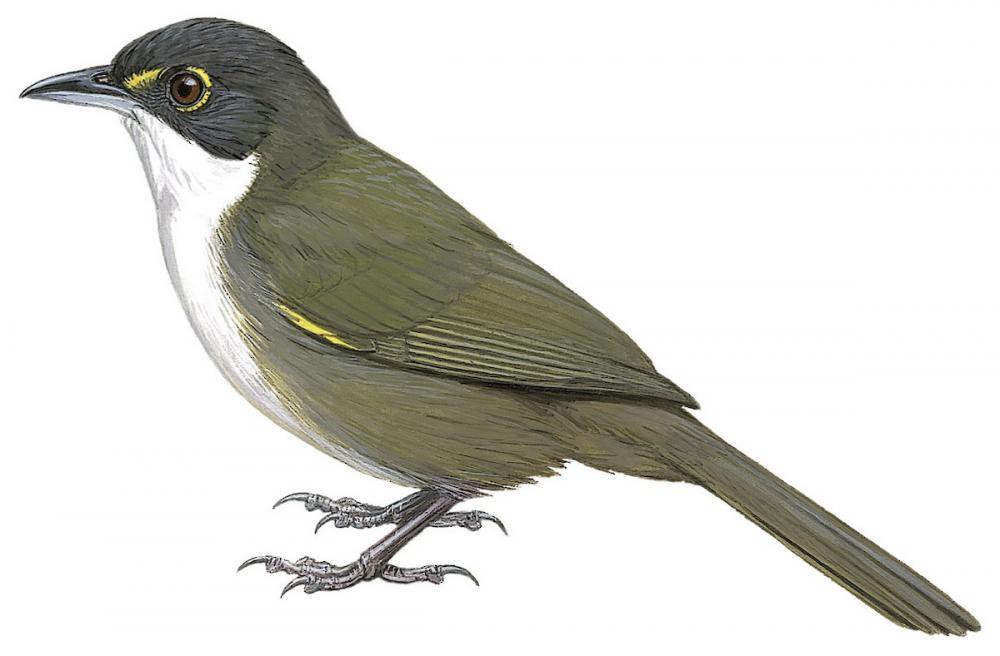Eastern Chat-Tanager / Calyptophilus frugivorus

Eastern Chat-Tanager
SCI Name:
Protonym: Phoenicophilus frugivorus Q.J.BostonZool.Soc. 2 p.45
Taxonomy: Passeriformes / Calyptophilidae / Calyptophilus
Taxonomy Code: eactan1
Type Locality: Santo Domingo ; type from Almercen [= Villa Rivas], fide Hellmayr, 1936, Field Mus. Nat. Hist. Publ., Zool. Ser., 13, pt. 9, p. 358.
Author: Cory
Publish Year: 1883
IUCN Status: Near Threatened
DEFINITIONS
CALYPTOPHILUS
(Calyptophilidae; Ϯ Eastern Chat-tanager C. frugivorus) Gr. καλυπτω kaluptō to hide; φιλος philos lover; "I have placed the present species in the genus Phœnicophilus, provisionally, as there are several points of difference which are sufficient, in my opinion, to constitute a new genus" (Cory 1883); "Calyptophilus,* gen. nov. The present genus has the general appearance, at first glance, of Phœnicophilus, but is easily separated from it by the following characters: a. Tail short, about four-fifths as long as the wing; middle toe about two-thirds of tarsus; tail square, slightly emarginate. Phœnicophilus. b. Tail long, equal to wing; middle toe about five-sixths of tarsus; tail rounded, and strongly graduated; bill much narrower, and the legs and feet larger than in Phœnicophilus. Calyptophilus. Calyptophilus frugivorus. Phœnicophilus frugivorus CORY, Journ. Boston Zoöl. Soc., II, No. 4, Oct. 1883, p. 45. ... * Kαλυπτος. φιλεω." (Cory 1884); "Calyptophilus Cory, 1884, Auk, 1, p. 3. Type, by monotypy, Phoenicophilus frugivorus Cory." (Storer in Peters, 1970, XIII, p. 278).
frugivorus
L. frux, frugis fruit; -vorus -eating < vorare to devour.
SUBSPECIES
Eastern Chat-Tanager (frugivorus)
SCI Name: Calyptophilus frugivorus frugivorus
frugivorus
L. frux, frugis fruit; -vorus -eating < vorare to devour.
Eastern Chat-Tanager (neibae)
SCI Name: Calyptophilus frugivorus neibae
neibae / neibei
Sierra de Neiba, Dominican Republic.
Eastern Chat-Tanager (abbotti)
SCI Name: Calyptophilus frugivorus abbotti
abbotti
● Dr William Louis Abbott (1860-1936) US surgeon, explorer, ethnologist, naturalist who collected widely around the world 1883-1923 (syn. Brachypodius atriceps baweanus, syn. Butorides striata javanica, subsp. Cacatua sulphurea, ‡subsp. Calyptophilus frugivorus, Celebesica, syn. Chlorophoneus multicolor, subsp. Cinnyris souimanga, syn. Coccyzus minor, subsp. Cyanecula svecica, ‡subsp. Dryolimnas cuvieri, syn. Hirundo tahitica javanica, subsp. Hypothymis azurea, syn. Kittacincla malabarica tricolor, syn. Lybius leucocephalus albicauda, subsp. Megapodius nicobariensis, subsp. Nesoctites micromegas, subsp. Nyctibius jamaicensis, Papasula, syn. Phodilus badius, subsp. Pitta sordida, subsp. Psittacula alexandri, Psittinus, subsp. Spilornis cheela, syn. Streptopelia picturata rostrata, subsp. Threskiornis bernieri, syn. Treron vernans).
● Lt.-Col. John Richard Abbott (1811-1888) British Army, Assistant-Commissioner of the Arakan, Burma 1837-1845 (Malacocincla).
● Dr Charles Greeley Abbott (1872-1973) US astrophysicist, solar researcher, Secretary of the Smithsonian Institution 1928-1944, Secretary Emeritus 1944-1973 (syn. Tychaedon coryphoeus).
UPPERCASE: current genus
Uppercase first letter: generic synonym
● and ● See: generic homonyms
lowercase: species and subspecies
●: early names, variants, mispellings
‡: extinct
†: type species
Gr.: ancient Greek
L.: Latin
<: derived from
syn: synonym of
/: separates historical and modern geographic names
ex: based on
TL: type locality
OD: original diagnosis (genus) or original description (species)












